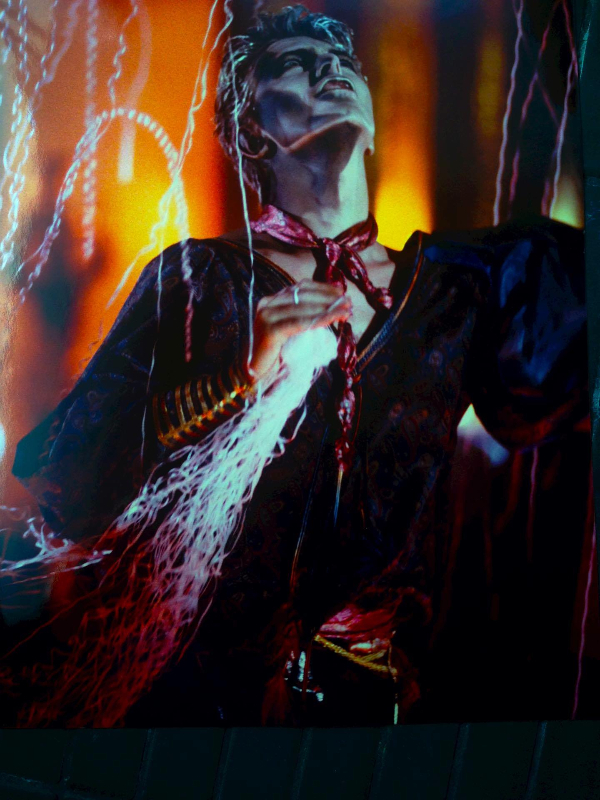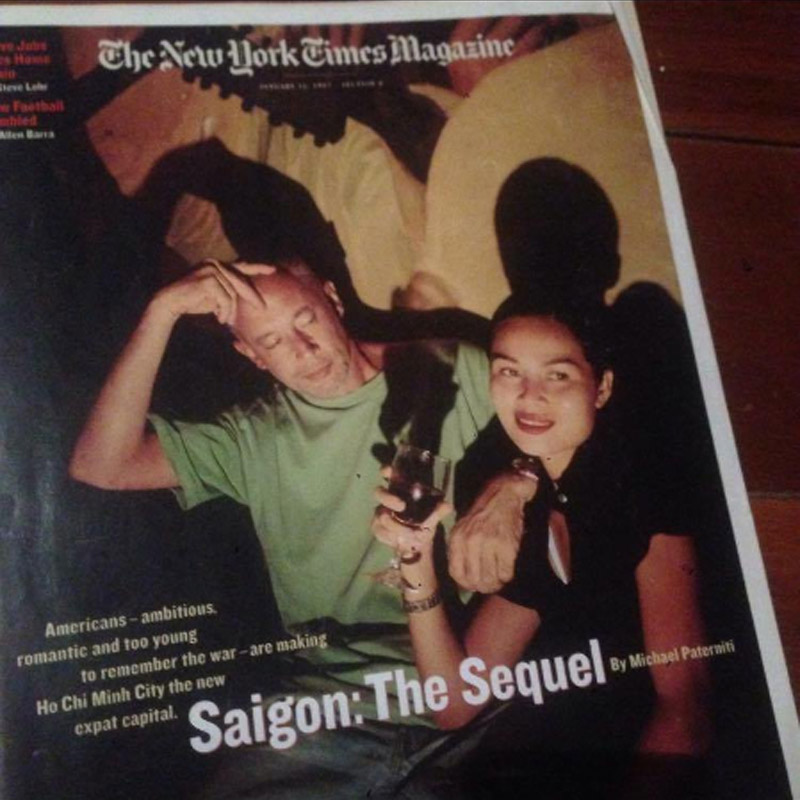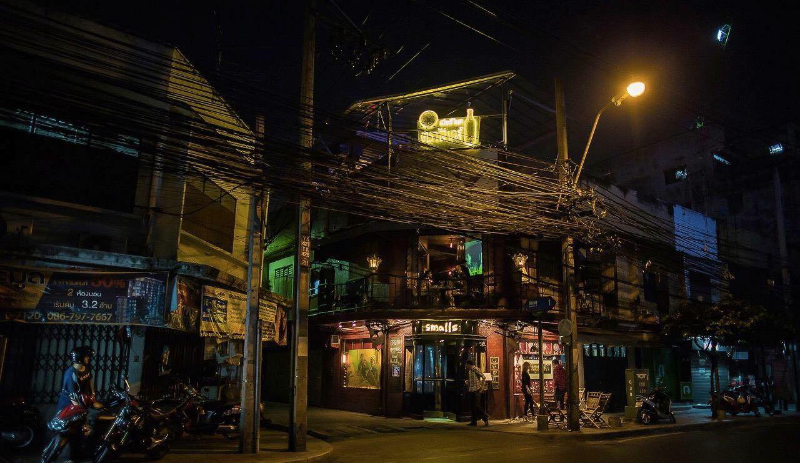In Coconuts’ “The Expat Files,” writer Jim Algie picks the brains of the most famous — and infamous — foreigners in Thailand.
Considering all the celebs that bar owner David Jacobson has met while working as a photographer in the US and in the hospitality business in Southeast Asia — A-listers including David Bowie, Robert De Niro, Andy Warhol and Muhammad Ali — it’s surprising to hear that the most moving personal encounter he had was with the late co-founder of Atlantic Records, Ahmet Ertegun.
“He signed everyone, John Coltrane, Ray Charles, Aretha Franklin. He was always voted best-dressed man in New York. A Turkish guy coming to America and doing what he did, to have the kind of ear he did, which made my childhood worthwhile, my first slow dance, my first dry hump, my first everything,” recalled Jacobson.
That anecdote set the stage for a conversation with the co-founder of Smalls, one of Bangkok’s best bars. Jacobson spoke of his years as a commercial photographer in partnership with the renowned Greg Gorman back in the 1980s and was as complimentary of some celebrities, like the late Bowie (“friendly and intelligent, he knew how to work the camera”), as he was critical of others, calling actor William Hurt “insanely obnoxious.”

The New Yorker’s shoot-from-the-hip style of talking did not endear him to some of the pampered stars he was supposed to pander to. “The reason I quit the business is I have the wrong temperament. Greg loved celebrities, and when Sissy Spacek came into the studio, she has these tiny little squinty eyes, and he’d say, “Did you have a facelift? Your eyes look fabulous. You’ve never looked better,” and I’d always think they’re not gonna swallow it, but they always did. Most celebrities don’t care about interesting photography. They wanna look five to 10 years younger and that’s it.”

Hollywood can be a vampire that sucks the lifeblood and creative juices out of many young talents before they are discarded so the movie moguls can bring in fresh meat to bleed dry. Figuring that if he were not a high-flying millionaire by the time he hit 40, Jacobson would have to reroute his career path.


In a plot twist most Hollywood hacks would write off as too far-fetched for a biopic, the photographer took an assignment documenting the efforts of the first American NGO to airlift medical supplies from Cambodia to Vietnam at a time when the Americans, Chinese, and Thais still refused to recognize the Vietnamese government and disallowed any foreign aid to Cambodia, a fact that meant the flag of the genocidal Khmer Rouge still flew outside the United Nations and its leader, Pol Pot, had a holiday home in Pattaya and enjoyed day trips to Bangkok.
In 1991 Phnom Penh, doctors and electricity were in short supply while the emergency rooms and medical equipment dated back to World War II. In Saigon, the only foreigners were Russians, and Jacobson said he saw maybe 20 new cars in the entire city.
Under conditions he described as “absolutely shocking,” he turned the eye of his camera away from the stardust of Tinseltown and into the heart of darkness, shooting the Cambodian genocide’s aftermath and the fallout from the Vietnam War — such as babies born with grotesque birth defects, a result of Agent Orange contamination.
At the time, he was with his Vietnamese girlfriend, who had recently fled to the US as a boat person, enduring her own personal tragedies – the boat was shipwrecked, her sister drowned – only to find herself back in her troubled homeland. When the couple returned to Saigon the next year, the Russians had departed and the city teemed with Asian and European businessmen eager to get in on the ground floor of the new building boom. In spite of all the rampant development, Jacobson said in his Bronx-heavy rasp, “There wasn’t one good fucking bar in the whole city.”
With a bankroll of US$30,000 that he raised by selling all his camera gear, Jacobson and his girlfriend set out to write a new chapter in the story of Saigon’s nightlife by constructing the city’s first real Western-style bar in a colonial-era French opera house. Since Vietnam was a land of penury, not plenty, while Saigon was still stuck in a drab limbo of communist conformity, they had to employ the woodworking skills of coffin-makers and other traditional craftsmen to make all the furnishings – bar stools, light fixtures, door knobs – from designs drawn by Jacobson.
Location may be crucial to the success of any such venture, but the timing of Q Bar’s launch also played a significant role in its success. It opened in 1995, just before the 20th anniversary of the fall of Saigon brought every foreign correspondent who had ever covered the Vietnam War back to town. This notoriously hard-boozing bunch caroused and coagulated at Q Bar. The word-of-mouth spewed by the journalists spread like breaking news on the media newswire.

Soon, Time magazine named it one of the world’s best bars. David and his girlfriend appeared on the cover of the New York Times Sunday Magazine. Then Gary Trudeau drew the bar and its revolving cast of colorful – or off-color – characters for some 15 Doonesbury cartoon strips featuring a Hunter S. Thompson-like journalist named Duke.
The A-list of celebrity contacts that Jacobson cultivated in Hollywood added more luster to the bar’s rising star. First Matt Dillon visited. “All the hot girls in Vietnam would circle him, but he had a crush on my bookkeeper who had no idea who he was and refused to go out with him,” said Jacobson, hacking up a smoker’s laugh.

Dillon, whom Jacobson describes as a “regular guy who never left New York for Hollywood,” introduced him to Robert De Niro. In person, the star of such films as Taxi Driver, Raging Bull and Good Fellas, was “very much how you would expect him to be… a guy with a lot of expressions but very little conversation.”

Thanks to social media and celebrity gossip sites like TMZ, we can all get a glimpse of the rich and infamous in more everyday settings, as well as the fawning fans who throng red-carpet awards shows, but Jacobson has seen it all through his viewfinder and, later, across the bar.
The Saigon Q Bar was open from 1992 until 2008 and Jacobson opened it’s reincarnation under the same name in Bangkok in 1999 with partner Andrew Clark.
It was Bangkok’s first truly cosmopolitan nightclub, with international DJs, well-taught staff who knew the difference between scotch and bourbon, and elaborately concocted drinks. Jacobson watched as Dillon suffered an infestation of leeches disguised as admirers who had confused him with his brother, saying, “I loved you in Platoon. ‘That wasn’t me, it was my brother.’ No, it was you.”
The Bangkok Q Bar changed owners in 2012 and closed in 2015 due to high expenses.
Dillon, and other high-profile clientele like Owen Wilson and Harry Styles of One Direction, prefer the laid-back atmosphere at Smalls, Jacobson’s newer venue on Soi Suan Plu, opened in partnership with the artist and photographer Bruno Tanquerie in 2014.
This bar-cum-restaurant-cum-art-space conjures up the spirit — if not the look and ambience — of Q Bar Saigon, “A small bar about good conversation, good drinks, good décor and art,” said Jacobson.
Smalls scored big at the recent Bar Awards Bangkok with five nominations. Jacobson won the Best Hospitality Ambassador accolade and his bar hosted the after-hours event.
At his Soi Suan Plu watering hole, the music policy remains as staunchly anti-commercial as the art and photography, curated by Jacobson and Tanquerie. His only directive to the crew of top-notch DJs, like IZZY IZZY (Mondays), Scott Hess (Thursdays), Fredrik Funk (Fridays), Justin Mills (Saturdays) and DJ Pump (Sundays), is, “Play what made you fall in love with music. If someone requests Beyonce, you can say no. I want a reputation as a bar that plays alternative music.”
That policy extends to the live jazz on Wednesday nights, where the city’s top jazz musicians are given free rein to create whatever avant-garde cacophony or mellow brew they want.
Bereft of the hi-so snobbishness that gives so many upscale bars in Bangkok an ambience of frigidity above and beneath the Arctic air-conditioning, Jacobson likens the warm vibe to the old sitcom Cheers. “It’s corny but it’s a place where everyone knows your name.”
The venue has also attracted a growing number of Thai regulars, partially because it’s not a pick-up joint and Romeos in rut are discouraged from running hormonally rampant. “If a farang guy hassles a Thai girl, I’m the first one on his ass. I’ll pay your bill but you gotta go now,” he said, adding that he finds the whole concept of Models’ Nights and Ladies’ Nights — getting women drunk for free so men can hit on them — misogynistic.

Smalls is part of a movement, which has now outlasted the faddish phase, that has made Bangkok’s nightlife a whole lot cooler in recent years. He singles out other venues like FooJohn, SoulBar, Tropic City, Backstage and Teens of Thailand for praise while acknowledging his own role as a catalyst.
“I can honestly say, with a lot of humility, that I changed the drinking habits in two countries, Vietnam and Thailand, and that’s why the old-timers here call me ‘godfather,’ because I was the godfather of the nightlife industry,” he said.
The New York-native just turned 71 and has no plans to retire. The bar, he said, “keeps me relevant. I meet people, writers, filmmakers, journalists, musicians, U-boat captains, Burma experts, and they come here and talk to me about it… people who are into art, which is hard to find in Asia, but we attract them, too. It’s a conversation bar. People come here to talk. It’s not a shake-your-ass bar where people look at their phones all night and go ‘what? what? what?’ because they can’t hear each other.”
The man’s keen edge has not been dulled by the passage of time. His demeanor, by turns prickly and combative, or funny and affable, is much the same as when I first interviewed him for Living in Thailand magazine back in 2001 about his extensive collection of Chinese and Vietnamese antiques.
Most interviews I do last 40 or 50 minutes at most. Now we’re close to the two-hour mark and Jacobson is just launching into a story about a mutual hero of ours: Muhammad Ali.
You would have to have testicles of titanium to dare and rouse the great heavyweight champion, civil-rights activist, and anti-war protestor from a state of exhaustion, but that was how he described the scene. Ali was being photographed by Jacobson and was tired after a long day of work. Worried that the photos would turn out poorly, Jacobson whispered in the heavyweight’s ear while they were doing the Polaroid set ups for the lighting.
“You know Ali, you’re getting old, you’re getting fat and you’re not the man you were when you did Requiem for a Heavyweight. That’s from an old movie he made under the name Cassius Clay, when nobody knew him, and he fights Anthony Quinn. So he jumped up and that’s when this photo was taken of me and him. He said, ‘Okay, take a photo of this, take a photo of that, and he started doing magic tricks, pulling coins out of my ears and all of a sudden he was alive and we got a decent photo.”

Jim Algie’s latest book is an expanded edition of “On the Night Joey Ramone Died: Tales of Rock and Punk from Bangkok, New York, Cambodia and Norway,” which contains a new 130-page section of “Rock Writings and Musical Memoirs,” and a cover blurb from the acclaimed author, Timothy Hallinan: “The funniest sad book and the saddest funny book I’ve read in a long time.” The book is available as a paperback or ebook from Amazon.com.
Check out the previous episode of The Expat Files: Celebrity English teacher Andrew Biggs talks about life in Thailand



Reader Interactions